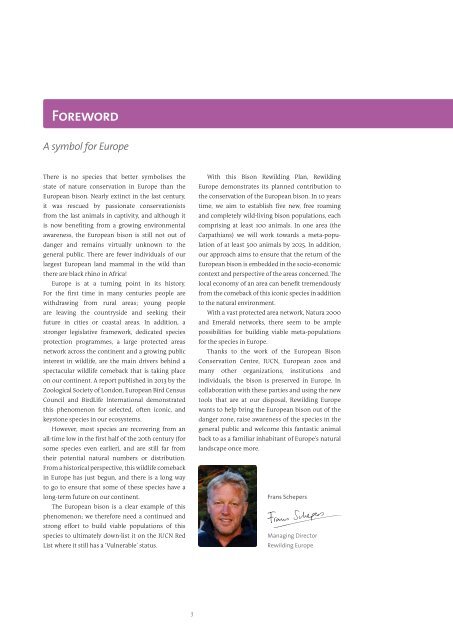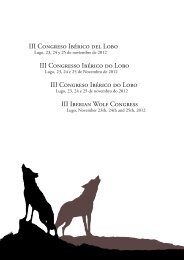Bison-Rewilding-Plan-2014
Bison-Rewilding-Plan-2014
Bison-Rewilding-Plan-2014
- No tags were found...
You also want an ePaper? Increase the reach of your titles
YUMPU automatically turns print PDFs into web optimized ePapers that Google loves.
ForewordA symbol for EuropeThere is no species that better symbolises thestate of nature conservation in Europe than theEuropean bison. Nearly extinct in the last century,it was rescued by passionate conservationistsfrom the last animals in captivity, and although itis now benefiting from a growing environmentalawareness, the European bison is still not out ofdanger and remains virtually unknown to thegeneral public. There are fewer individuals of ourlargest European land mammal in the wild thanthere are black rhino in Africa!Europe is at a turning point in its history.For the first time in many centuries people arewithdrawing from rural areas; young peopleare leaving the countryside and seeking theirfuture in cities or coastal areas. In addition, astronger legislative framework, dedicated speciesprotection programmes, a large protected areasnetwork across the continent and a growing publicinterest in wildlife, are the main drivers behind aspectacular wildlife comeback that is taking placeon our continent. A report published in 2013 by theZoological Society of London, European Bird CensusCouncil and BirdLife International demonstratedthis phenomenon for selected, often iconic, andkeystone species in our ecosystems.However, most species are recovering from anall-time low in the first half of the 20th century (forsome species even earlier), and are still far fromtheir potential natural numbers or distribution.From a historical perspective, this wildlife comebackin Europe has just begun, and there is a long wayto go to ensure that some of these species have along-term future on our continent.The European bison is a clear example of thisphenomenon; we therefore need a continued andstrong effort to build viable populations of thisspecies to ultimately down-list it on the IUCN RedList where it still has a ‘Vulnerable’ status.With this <strong>Bison</strong> <strong>Rewilding</strong> <strong>Plan</strong>, <strong>Rewilding</strong>Europe demonstrates its planned contribution tothe conservation of the European bison. In 10 yearstime, we aim to establish five new, free roamingand completely wild-living bison populations, eachcomprising at least 100 animals. In one area (theCarpathians) we will work towards a meta-populationof at least 500 animals by 2025. In addition,our approach aims to ensure that the return of theEuropean bison is embedded in the socio-economiccontext and perspective of the areas concerned. Thelocal economy of an area can benefit tremendouslyfrom the comeback of this iconic species in additionto the natural environment.With a vast protected area network, Natura 2000and Emerald networks, there seem to be amplepossibilities for building viable meta-populationsfor the species in Europe.Thanks to the work of the European <strong>Bison</strong>Conservation Centre, IUCN, European zoos andmany other organizations, institutions andindividuals, the bison is preserved in Europe. Incollaboration with these parties and using the newtools that are at our disposal, <strong>Rewilding</strong> Europewants to help bring the European bison out of thedanger zone, raise awareness of the species in thegeneral public and welcome this fantastic animalback to as a familiar inhabitant of Europe’s naturallandscape once more.Frans SchepersManaging Director<strong>Rewilding</strong> Europe3



